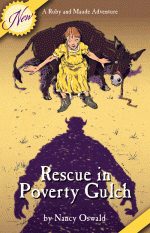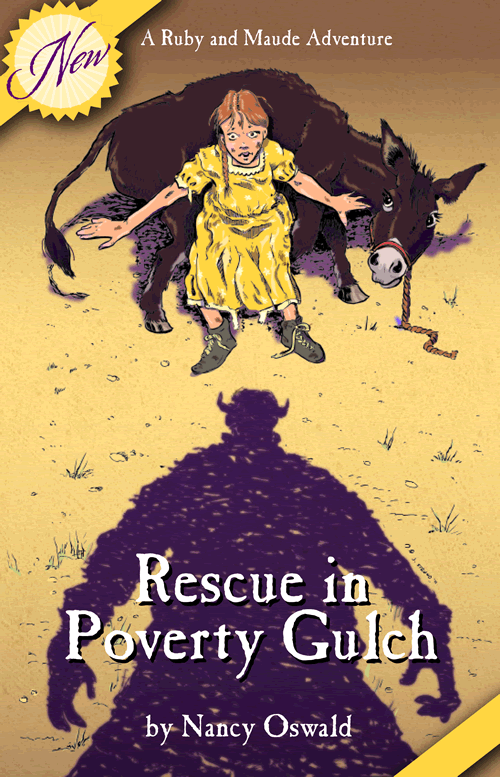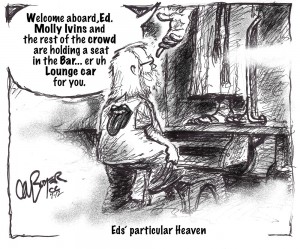Rescue in Poverty Gulch
Historical Fiction for Ages 8 and up
By Nancy Oswald
Filter Press, paperback, 185 pp, $8.95
Reviewed by Annie Dawid
The first in a new series by Cotopaxi author Nancy Oswald, Rescue in Poverty Gulch will delight children who get their hands on this book as well as the adults who read it to youngsters. Oswald’s stories appeal to readers in search of lively characters and rich local history.
Eleven-year-old Ruby and her ice-cream-eating donkey, Maude, live in the Cripple Creek of 1896. A cheeky and funny girl, Ruby has loved the peripatetic outdoor existence she and her father have lived since Ruby’s mother died. Their world comprises the Arkansas River valley and surrounding areas. An encounter with a thief, precipitated by a recalcitrant Maude, causes the three-member family to settle down in Cripple Creek, an enormous and undesired change in Ruby’s way of life.
“The day had started out like any other – a cool morning breeze, the smell of coffee on the campfire. Now Pa had a job and wanted to rent a cabin. She took a deep breath. Had Pa lost his mind? He wouldn’t like living under a roof any more than she would.”
Not only must Ruby now live indoors, but she is required to attend school, though her father has been tutoring her in “book learning” all along, and Ruby thinks she already knows all she needs to know. Her life as a student, in what Huck Finn derisively calls “sivilization,” begins badly. “Ruby fidgeted. The desk wrapped around her like a stiff harness.”
Oswald uses wonderful metaphors throughout the narrative to illustrate the way Ruby fits – and does not fit – into her new world. The girl who sits in front of Ruby has hair “braided and pinned to the back of her head, reminding Ruby of a coiled snake. Agnes Gribbell, Ruby decided, was the teacher’s pet. Her arm shot up as if Miss Logan were a puppeteer and had a string tied to it.”
The headmistress, who rides a bicycle, which she calls her “conveyance,” appears at first to be a stereotypical schoolmarm. Prim and bespectacled, she tackles her job of socializing the miners’ rough offspring, as well as the children of wealthy mine owners, with great sincerity and Victorian zeal. On their first day in Cripple Creek, Pa collides with Miss Sternum, named by Oswald with Dickensian flair. “The front wheel of the contraption wrenched sideways, and the woman flew over the handlebars, toppling Pa and taking him down with her. Ruby gaped at the tangle of arms and legs and hats and boots thrashing on the ground at her feet.”
But Miss Sternum turns out to be far less stiff than her upright posture – reminding the reader of Miss Gulch in The Wizard of Oz – might imply. As the story unfolds, Miss Sternum’s character acquires more and more nuance. Doubtless she will figure in the books to follow, as Rescue in Poverty Gulch is described as “Book One in the Adventures of Ruby and Maude.”
Eventually, Ruby makes friends, primarily through Maude, who accompanies Ruby to school every day and waits outside during lessons. The other children feed her precious treats from the contents of their meager lunches, and Ruby must learn to share her beloved donkey, whom she regards as another human being, with others.
In those days, donkeys were brought to the mines to haul ore underground, and they lived in the darkness for years, eventually going blind. Early in the story, a man offers to buy Maude from Ruby. “The mines is payin’ plenty for good, stout stock.” Offended, Ruby informs him, “My donkey’s not for sale.” The menacing prospective buyer, along with the aforementioned thief, provide tension and antagonists for Ruby’s and Maude’s adventures in Poverty Gulch – to be continued.
Annie Dawid writes and makes art in Westcliffe, where she runs BloomsburyWest, a retreat. Her assemblages will be part of a group show at the Third Street Gallery during the month of August. Her last book, And Darkness Was Under His Feet: Stories of a Family, was reviewed in Colorado Central.



